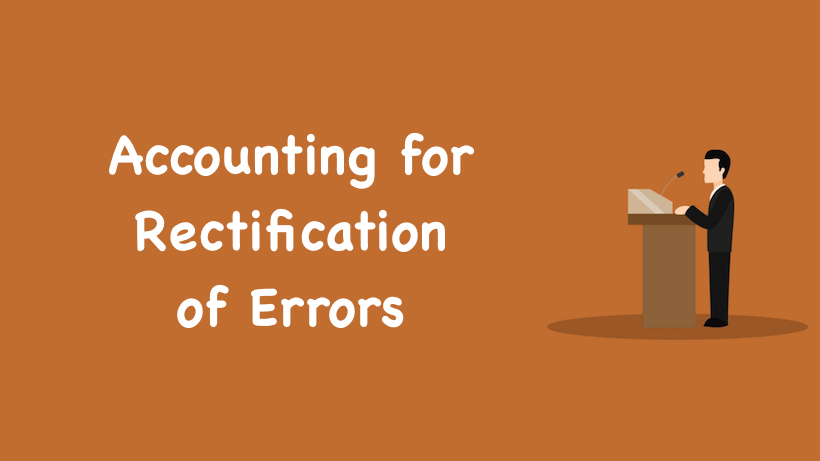Accounting for Rectification of Errors , To err is human! So, it is obvious that while we are doing the accounting of an entity, we can make mistakes. But more important is to analyze & correct the mistakes. So here, we are providing the basics of Accounting for Rectification of Errors. Here, we will have a look on how to rectify the errors if those are found in the same financial year or later on.
Accounting for Rectification of Errors
Basic features of correct accounting:
- All transactions & events must be recorded/ entered.
- Transactions & events must be recorded by Double entry system & by following proper accounting Principles.
- All entries must be fully & correctly posted to ledger accounts.
- There must be arithmetical accuracy:
- in Recording i.e. passing entry,
- in Posting figures in accounts,
- in totaling & balancing of books of Entry &
- in totaling & balancing of ledger accounts.
Must Read – Accounting for Not for Profit Organisation
ERROR
Meaning of an Error
If in books of account any one or more of the above mentioned basic elements/features of correct accounting is not followed, then we will say an error/mistake has been committed.
Classification of Errors:
- Errors of Principle:
- That means there is error in applying some accounting Principle,
- Such errors will not affect the agreement of trial balance i.e. these are double sided error.
Ex. Treating a revenue expense as capital expenditure or vice versa or the recording of sale of a fixed asset as ordinary sale.
Must Read – Detailed Analysis of a Bank Reconciliation Statement
- Clerical Errors:
- These are the errors committed in applying the accounting procedure.
- Such errors may or may not affect the agreement of trial balance.
Rectification in the same year can be:
- Before preparation of Trial Balance i.e. without opening a Suspense a/c or
- After preparation of Trial Balance i.e. after opening a Suspense a/c.
Suspense Account:
- When trial balance does not tally, the difference is put to an account named as Suspense a/c. Difference is:
- debited to suspense a/c (if debit side of trial balance is short) or
- credited to suspense a/c (if credit side of trial balance is short)
- Thus with the help of suspense a/c trial balance is artificially tallied.
Must Read – Various Types of Vouchers In Accounting
Rectification In Subsequent Years Books
Rectification in the next year:
- If errors are located after finalizing the accounts then it should be rectified in the next years accounts.
- The difference of Trial balance will also get transferred to next years books under the name Suspense a/c.
- This will involve preparation of Profit & Loss Adjustment account.
Profit & Loss Adjustment account:
- The rectification entry will be same as passed in case of rectification in same year except that wherever any Income or Expenses a/c. is involved, the Debit/Credit will be made in P&L adjustment a/c. and not in the Income or Expenses a/c.
- Otherwise this years profit will be affected by the errors of last year.
- The balance in P&L adjustment a/c. will be transferred to capital a/c in the case of proprietorship or partnership concern or to Profit and Loss Appropriation account in the case of a company.
Must Read – Analysis of Guidance Note on Accounting for Depreciation
Forming Rectification Entry:
Steps to be followed for solving a rectification problem are as follows:
- An account is not debited or less debited ¬ debit it
- An account is not credited or less credited ¬ credit it
- An account is wrongly debited or more debited ¬ credit it
- An account is wrongly credited or more credited ¬ debit it
- After making above if double entry is not yet completed, then make it double entry by debiting or crediting the difference to suspense a/c.
- If rectification is being done in subsequent year then in place of income & expenses account, P & L adjustment account will be debited or credited, as the case may be.
Recommended Articles

Rectification of error ke case mein..kaise pata chalega which is suspense account. & p&l adjustments. Will be debited or credited in which case p&l adjustment account will be debited or credited